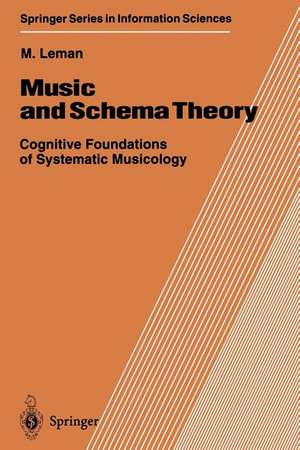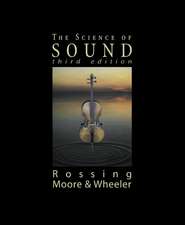Music and Schema Theory: Cognitive Foundations of Systematic Musicology: Springer Series in Information Sciences, cartea 31
Autor Marc Lemanen Limba Engleză Paperback – 15 dec 2011
Din seria Springer Series in Information Sciences
- 20%
 Preț: 337.66 lei
Preț: 337.66 lei - 18%
 Preț: 955.08 lei
Preț: 955.08 lei - 15%
 Preț: 646.62 lei
Preț: 646.62 lei - 20%
 Preț: 337.52 lei
Preț: 337.52 lei -
 Preț: 385.62 lei
Preț: 385.62 lei -
 Preț: 381.98 lei
Preț: 381.98 lei -
 Preț: 391.61 lei
Preț: 391.61 lei - 20%
 Preț: 324.64 lei
Preț: 324.64 lei -
 Preț: 380.84 lei
Preț: 380.84 lei - 18%
 Preț: 777.69 lei
Preț: 777.69 lei -
 Preț: 387.96 lei
Preț: 387.96 lei -
 Preț: 396.62 lei
Preț: 396.62 lei - 20%
 Preț: 330.75 lei
Preț: 330.75 lei -
 Preț: 382.57 lei
Preț: 382.57 lei - 15%
 Preț: 642.18 lei
Preț: 642.18 lei - 15%
 Preț: 640.06 lei
Preț: 640.06 lei -
 Preț: 387.58 lei
Preț: 387.58 lei - 20%
 Preț: 333.40 lei
Preț: 333.40 lei -
 Preț: 386.99 lei
Preț: 386.99 lei - 20%
 Preț: 653.71 lei
Preț: 653.71 lei - 15%
 Preț: 661.02 lei
Preț: 661.02 lei - 18%
 Preț: 1391.21 lei
Preț: 1391.21 lei - 15%
 Preț: 642.68 lei
Preț: 642.68 lei -
 Preț: 386.00 lei
Preț: 386.00 lei - 20%
 Preț: 649.60 lei
Preț: 649.60 lei - 18%
 Preț: 950.21 lei
Preț: 950.21 lei -
 Preț: 393.35 lei
Preț: 393.35 lei - 20%
 Preț: 652.41 lei
Preț: 652.41 lei - 20%
 Preț: 645.65 lei
Preț: 645.65 lei -
 Preț: 390.25 lei
Preț: 390.25 lei -
 Preț: 387.96 lei
Preț: 387.96 lei - 15%
 Preț: 580.97 lei
Preț: 580.97 lei
Preț: 638.43 lei
Preț vechi: 751.10 lei
-15% Nou
Puncte Express: 958
Preț estimativ în valută:
122.17€ • 127.87$ • 101.68£
122.17€ • 127.87$ • 101.68£
Carte tipărită la comandă
Livrare economică 31 martie-14 aprilie
Preluare comenzi: 021 569.72.76
Specificații
ISBN-13: 9783642852152
ISBN-10: 3642852157
Pagini: 256
Ilustrații: XIII, 234 p.
Dimensiuni: 155 x 235 x 13 mm
Greutate: 0.36 kg
Ediția:Softcover reprint of the original 1st ed. 1995
Editura: Springer Berlin, Heidelberg
Colecția Springer
Seria Springer Series in Information Sciences
Locul publicării:Berlin, Heidelberg, Germany
ISBN-10: 3642852157
Pagini: 256
Ilustrații: XIII, 234 p.
Dimensiuni: 155 x 235 x 13 mm
Greutate: 0.36 kg
Ediția:Softcover reprint of the original 1st ed. 1995
Editura: Springer Berlin, Heidelberg
Colecția Springer
Seria Springer Series in Information Sciences
Locul publicării:Berlin, Heidelberg, Germany
Public țintă
ResearchCuprins
1. Introduction.- 2. Tone Semantics.- 2.1 The Problem of Tone Semantics.- 2.2 Historical Background.- 2.3 Consonance Theory.- 2.4 Cognitive Structuralism.- 2.5 The Static vs. Dynamic Approach.- 2.6 Conclusion.- 3. Pitch as an Emerging Percept.- 3.1 The Two-Component Theory of Révész.- 3.2 Attribute Theory Reconsidered.- 3.3 The Shepard-Tone.- 3.4 Paradoxes of Pitch Perception.- 3.5 The Shepard-Illusion.- 3.6 Ambiguous Stimuli.- 3.7 Conclusion.- 4. Defining the Framework.- 4.1 The Computer Model.- 4.2 Representational Categories.- 4.3 Conclusion.- 5. Auditory Models of Pitch Perception.- 5.1 The Missing Fundamental.- 5.2 Auditory Models.- 5.3 SAM: A Simple Model.- 5.4 TAM: A Place Model.- 5.5 VAM: A Place-Time Model 53.- 5.6 Conclusion.- 6. Schema and Learning.- 6.1 Gestalt Perception.- 6.2 Tone Semantics and Self-Organization.- 6.3 SOM: The Self-Organizing Map.- 6.4 Architecture.- 6.5 Dynamics.- 6.6 Implementation.- 6.7 Conclusion.- 7. Learning Images-out-of-Time.- 7.1 SAMSOM.- 7.2 TAMSOM.- 7.3 VAMSOM.- 7.4 Conclusion.- 8. Learning Images-in-Time.- 8.1 Temporal Constraints in Tonality Perception.- 8.2 Tone Images-in-Time.- 8.3 Tone Context Images.- 8.4 Determination of the Integration Period.- 8.5 TAMSOM.- 8.6 VAMSOM.- 8.7 Conclusion.- 9. Schema and Control.- 9.1 Schema-Based Dynamics.- 9.2 TCAD: Tone Center Attraction Dynamics.- 9.3 TCAD — Stable States.- 9.4 TCAD — Recognition.- 9.5 TCAD — Interpretation.- 9.6 The TCAD Model.- 9.7 TCAD — At Work.- 9.8 Conclusion.- 10. Evaluation of the Tone Center Recognition Model.- 10.1 Overview of Other Models.- 10.2 TCAD-Based Tone Center Analysis.- 10.3 The Evaluation Method.- 10.4 Bartók — Through the Keys.- 10.5 Brahms — Sextet No. 2.- 10.6 Chopin — Prélude No. 20.- 10.7 The Effect of Phrase — Re-evaluationof Through the Keys.- 10.8 Conclusion.- 11. Rhythm and Timbre Imagery.- 11.1 Models of Rhythm Perception.- 11.2 VRAM: A Rhythm Analysis Model.- 11.3 The Analysis of Timbre.- 11.4 Conclusion.- 12. Epistemological Foundations.- 12.1 Epistemological Relevance.- 12.2 Neurophysiological Foundations.- 12.3 Modular Organization.- 12.4 Relevance for a Theory of Meaning.- 12.5 Music Semantics and Meaning Formation.- 12.6 Epistemological Principles.- 12.7 Conclusion.- 13. Cognitive Foundations of Systematic Musicology.- 13.1 Cognitive Musicology, AI and Music, and Systematic Musicology.- 13.2 Historical-Scientific Background.- 13.3 New Developments in the 1960s.- 13.4 A Discipline of Musical Imagery.- 13.5 A Psycho-morphological Account of Musical Imagery.- 13.6 Interdisciplinary Foundations.- 13.7 General Conclusion.- A. Orchestra Score in CSOUND.- A.l The Orchestra File.- A. 2 The Score File.- B. Physiological Foundations of the Auditory Periphery.- B.1 The Ear.- B.2 The Neuron.- B.3 Coding.- B. 4 The Brain Stem and Cortex.- C. Normalization and Similarity Measures.- C. l Similarity Measures.- C.2 Towards a Psychoacoustic-Based Similarity Measure.- References.
Textul de pe ultima copertă
Music and Schema Theory Music is an important domain of application for schema theory. The perceptual structures for pitch and timbre have been mapped via schemata, with results that have contributed to a better understanding of music perception. Yet we still need to know how a schema comes into existence, or how it functions in a particular perception task. This book provides a foundation for the understanding of the emergance and functionality of schemata by means of computer-based simulations of tone center perception. It is about how memory structures self-organize and how they use contextual information to guide perception.
















